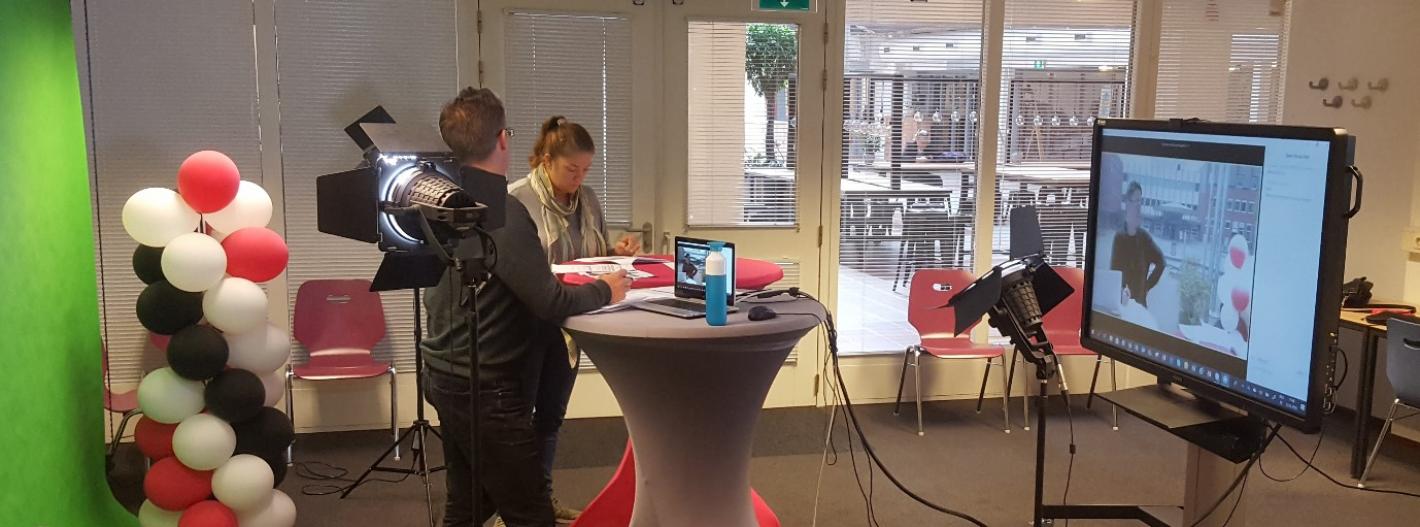 |
| Our studio set-up for the live Q&A |
On the tourism bachelor course where I teach, our third year tourism students follow an internship for 20 months at a tourism company, in locations all over the world. During that time they write a research report, but they sometimes find that a challenge. In my role as supervisor last year, I found that I was having the same ....
conversation with each of my different students at different times. This was inefficient and ineffective.
Surely there must be a better way?
Inspired to help students via live on-line Q&A
Having visited the BARCO headquarters in Kortrijk earlier this year (see my blog here) I was inspired to use the possibilities of technology to offer an online class to our internship students.
Discussing it with colleagues, we developed an online Q&A for our students in their ‘dispersed’ locations around the world. Students were informed at the start of their internship in September that there would be a live ‘Q & A’ session on 25th September. In advance, we sent specific instructions to prepare for the session by watching two relevant web lectures, read the internship handbook, to find a quiet room, to wear earphones, and to bring their questions to the session.
It took some preparation…
Colleagues Tom Visscher and Nico Grijpink set up the live video session using ZOOM video conferencing. The simple installation process (it took me about 30 seconds on my phone) involves downloading an app and clicking on the link to enter the session.
My colleague Manon Joosten and I practiced the week before via the ZOOM connection to get a feel for how the communication would go. Manon would answer questions on research, and I would act as moderator of the session. Tom and Nico checked audio, lighting and connections. We tested where to look (the web cam above the screen) and how to use the chat function to interact with the students. It was also important with two presenters to consider non-verbal communication (looking at the other presenter when they were talking, or looking into the web cam when the student was talking). This set a positive tone and created an informal interaction between the two speakers. The setup was with two of us standing behind tables with a green screen backdrop on which we added the entrance to our Hogeschool. This set-up was informal and dynamic.
The first 45 minute Q&A sessions took place at 12.00 midday (for the students studying in English) and the second at 13.30 for those studying in Dutch. Although students would be working during the day (which is the point, after all!), we encouraged them if possible to be available.
 |
| Action! The online class has begun. |
Live from Diemen… is anyone there?
In the first session one out of the six students was able to join the session. She was well prepared and we easily talked for 30 minutes covering all aspects of the research process. Before we started we asked permission to record and share the session which was granted. During the session I actively considered the future viewers (to whom the link would be sent), to ensure that sufficient subjects were covered and that key questions were addressed in the session. As the research expert, Manon gave detailed and clear answers which are useful for all students in the same situation.
In the second session, 4 out of 30 students joined us. These four were all based in the Netherlands. Although our students in Spain, Australia, Indonesia and Costa Rica did not join us, we hope they will next time. This second session was slightly more complicated in that there were four students on the screen. Interaction went smoothly and all students had sufficient time to ask their questions and to contribute to the discussion. Working with a co-presenter went smoothly. Manon as the expert and me as the moderator.
All five students over both sessions joined us via their smartphone (resting on their desk/table) and with earphones. One student was on mute most of the time due to a noisy background, but un-muted to ask questions. We did not use the ‘chat’ or the polling function from ZOOM due to small the number of participants.
Both ZOOM sessions were recorded with the aim of sending a link of the recorded session to those students who could not attend. The first session recorded successfully, but the second one did not due to us using the same log-in for the two different sessions. Next time we’ll create two different links and record them separately.
 |
| Interaction via technology |
Feedback from students was positive. Technology worked, audio, lighting and bandwidth/speed were of reasonable quality. Students would like the session planned earlier in the work placement, but they had sufficient time and space to have their questions answered and the format was informal but on topic.
Was it all worth it for five students…?
Absolutely! Although the numbers involved were small for the trial, we learned a lot about how to do it and we viewed it very much as a practice session. In December we will promote it to students much more clearly in advance, share a link to this first version as an example, and we expect more students because it is planned just before the assignment deadline! And we hope to have at least 20 students for the next session which will raise the complexity regarding communication and test the capacity of the technology.
How could you benefit from video teaching to your dispersed students?
Consider which of your student groups are dispersed in different physical spaces and evaluate how you could use this kind of approach to achieve efficiencies in your organization. Perhaps you are already doing this and are ahead of the curve...?
Good luck and let me know how you get on…!
 |
|
What the students see
|


